American Sabbatical 002: 8/28-30/96
Vermont
8/28/96.. Vermont.
| Yesterday was our first full day on the road, and my butt already hurts. Too much driving, not
enough walking. We spent Tuesday night with David and Anci in
Woodbury, high up the Green Mountains, where David coached me
in nerdology. He had me downloading software from the net, including
a browser, and then sent me spinning into the web. There’s not
enough time in this life for spider games. I feel like a fly trapped
in puter-time, anyhow. David insists that it’s better to watch
TV while computing, so all the wait times get used, but I find
that sort of hyperactivity a bit crazed. In fact, the dissociative
quality of computing makes me nervous. I want to get the whole
story in sequence, but it’s a bits and pieces world. I did figure
out how to do E-mail, though, and our broadcast log begins here. |

Woodbury
(Click on images
to see blowups.)
|
We rolled down out of the Green Mountains onto the Champlain plain
at Burlington. Seth and Klara are talking about settling there
this winter, so we wanted to take a look. Young town with a lake
and mountains. Pretty good choice, I’d say. It was fog and drizzle
in the early morning hills, but the sun was out in the valley,
and summer hot by mid-day.
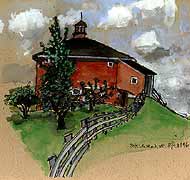
Shelburne Barn
(Bryce)
|
We went south along the lake to the Shelburne Museum where we
received a shock. Entrance fee (even with our senior citizen discount)
was $15 per. Ouch. I begged off and went outside to paint the
big round red barn, while Peggy did the tour. She griped to the
guides and they gave her a free pass for me, so I could see the
circus.
|
Shelburne is a very strange museum. A motley collection from all
periods of Americana, with some Impressionist classics thrown
in, all viewed in reconstructed Victorian buildings. In fact,
you could only look at the Manets and Cassats from the doorways
of period bedrooms and parlors. The circus is a collection of
splendid carved carousel animals and about a million carved and
painted circus performers, 8-12 inches tall. Great fun, but for
$15?
| We continued on down the Champlain Valley, through lush dairy
country full of shining silos. We realized that silos are an American
emblem. Towers of corn, the American grain. In the sultry haze
the big farms looked like Italian hill towns, and we stopped for
Peggy to do a pastel of a “Vermont Campanile”. Then we cranked
up Rory Block on the tunebox and roared through the wafting manure
to Steve and Mary Ellin’s house, high in the hills above Sandgate.
On the way we suddenly came out of the low rent New York border
towns into a clatch of chic boutiques: Montgomery, an outletville
like Freeport. It was amusing to see New Yorkers honking horns
and waving fists in the hills of Vermont. |
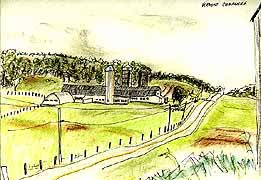
Vermont Campanile
(Peggy)
|
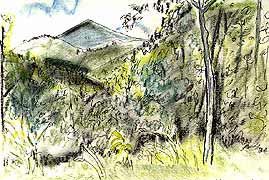
Sandgate
(Peggy)
|
Steve and Mary Ellin’s house is way up a two-track, with a spectacular
view of highhunched hills. One of the best parts of this trek
will be connecting with old friends, and Steve is our oldest friend: he introduced us. Steve’s 4-year-old showed us
how to hotdog a kiddiecar down the loose gravel driveway, and
how to make a dragon-boomer out of a stick and a puppet. Steve
is finishing up his new book “Eco-Pioneers” and is in the throes
of publishing deadlines. That’s the other side of dropping in
on people: they aren’t on sabbatical. Still it’s wonderful to
beard lions in their dens. We listened to Mary Ellin’s latest
tape. She’s starting a new career as a cabaret singer, and we
shared thoughts on the evolution of careers in the arts. Steve
and I agreed that we should stick with our chosen work, but evolve
our mindset. For sure we are going through changes this year.
More to follow. |
***
|
8/30...Plattsburgh
We spent Thursday morning on Sinner’s Hill in Sandgate watching the mountain view resolve
out of the mists. First Minister’s Hill, then the Reclining Woman,
finally Equinox Mt. and the bright blue sky. Then we rattled down
the rocky two-track and headed west again, out of the clumped-together
hills of Vermont into the wider valleys of New York. Up the west
side of the Champlain Valley, through shadowman territory (those
black silhouette lawn ornaments jumped out at us all day), to
Ticonderoga. After reading Rabble in Arms aloud last winter it
was exciting to see Skenesboro (“Birthplace of the US Navy”) and
other sites in the tale.
|
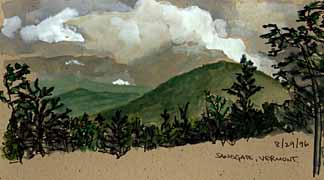
Sandgate
(Bryce)
|
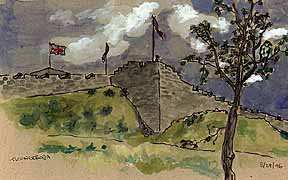
Ticonderoga
(Bryce)
|
Ticonderoga appears below you around a lakeside curve on Rt.22
much as Burgoyne’s men must have seen it from Mt. Defiance: a
very imposing structure guarding the passage to the North. Up
close the fort shrinks to human scale (is this true of all heralded
spots?), and the tales become more plausible. Peggy was totally
enthralled, pumped the guides, watched the reenactments, perused
the displays, was stirred by the rumble of drums in the stone
courtyard, the blast of canon. I went outside and down to the
foot of the battlements to get a sense of how hard it would be
to scale the walls, and how difficult for Knox to lower the canons
to the boats below. Not so dramatic a height as imagined. I sat
at the foot of the South wall and did a watercolor. A red-tail
hawk lit in the tree in the foreground and patiently watched while
I sketched him in.
|
We supped on bread and cheese and tea and headed up the lake to
the KOA campground (thank you Bilfil) at AuSable Chasm (thank
you Ktextor), getting in just before dusk and a shower, so we
were all snug and tented down for the night.
| Friday we began the day on foot, walking in the gorge (Ausable
Chasm). It was gorgeous. A great waterslice out of rectilinear
sandstone cliffs, with a roaring river in its throat. The engineering
and installation of the walkways and bridges was as fascinating
as the more sublime workmanship. What the Indians would have thought
about charging $9 a head for folks to walk in a gully? |
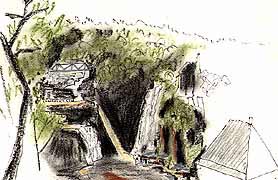
AuSable Chasm
(Peggy)
|
Having sweated off our breakfast in the company of Quebecois tourists
we set out on our next quest : the Rockwell Kent collection, supposedly
at Plattsburgh. But the campground phonebook said there was a
“Rockwell Kent Legacy” at a number in Ausable Forks, just up the
road. So we tracked it down (thanks to the local postmistress)
to a farm along a back road. Behind the farmyard (all painted
black and white) rose a chain of Adirondack peaks, looking for
all the world like one of Kent’s Greenland landscapes. The place
was called “Asgaard Farm”. But there wasn’t a soul in evidence.
After driving all over we stopped a woman walking the road and
she told us that Kent had indeed lived there and his widow still
did, but no longer gave openhouse tours, and Kent’s paintings
were at SUNY Plattsburgh.
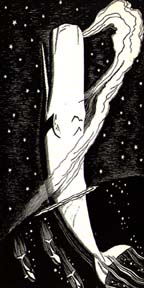
Illustration from Moby Dick
by Rockwell Kent
|
Thence we thithered. Hidden in the back of the library, behind
the turmoil of university reconstruction, is a gem of a collection:
paintings, prints, china (designed for MACY’S!!), etc., and an
enthusiastic docent and student aid who showed us all the special
treasures. It’s strange to be shown somebody’s old bookplates
by a reverent scholar in white gloves. I giggle to think that
some dogchewed Brycetoy might end up in a serious collection.
Yikes.
Eventually we staggered out into the sunshine, with our eyes full
of radiant sunsets, the dazzle on snow, and nubile Eskimo girls.
And we escaped from Plattsburgh into the Labor Day mountains,
with America in hot pursuit. |
Just west of Plattsburgh the Champlain Valley vegetation changes
into the arboreal forests we know and love. The oaks disappear
and big spruces darken the slopes. Lake Placid, Tupper and Long
Lakes are postcard visions of the North Woods, but the roadsides
here aren’t cluttered with the detritus of free enterprise, like
down home. This is a great parkland, so commerce is crowded into
the towns, and the highways are just for eyesfull. Our road, to
the Goodnow Flowage, winds and dips through paper company acreage
and descends to a spectacular gem. Right now the full moon is
shining down the length of the lake to this beautiful cottage
and I’m going to bed. G’night.
(At this point Peggy joins the conversation.)
(Memo #1)
August 30 - Rockwell Kent Day
WHO? 20th century American artist
WHAT? gallery of his artwork + his farm
WHERE ? SUNY Plattsburgh
WHEN? mid 20th century
HOW? owned farm in area, donated works to college
TOPICS: Rockwell Kent’s art / life, geography of Kent (he painted
in Greenland, Tierra Del Fuego, Monhegan, Ausable Forks, Ireland,
Newfoundland), McCarthyism & art, printmaking.
QUESTIONS: How you find marvels in your travels? |
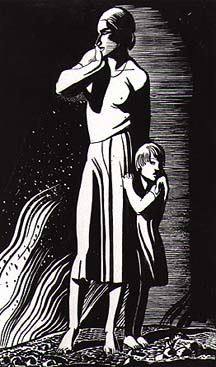
In the year of our Lord (Rockwell Kent)
SUNY Plattsburgh Art Museum
|
Today was Rockwell Kent Day with serendipity on our side. We had seen a Rockwell Kent Gallery
in Plattsburgh mentioned in small print under a reproduction in
an art book, and this spurred us to come to Plattsburgh, New York.
We knew nothing more. Had he lived here? Worked here? Had a daughter
at SUNY? Ideally, we would have done research before, but on everything?
At our KOA campground I looked in the phonebook and found “R.
Kent Legacies, Asgaard Farm” and a phone number. That sounded
perfect. I asked where the exchange was and was told Ausable Forks.
We looked on a map and headed there. No signs for the illustrious
painter anywhere on Main Street, Ausable Forks, so we stop in
the Post Office and ask. “Oh, yes, cross the little bridge, follow
the river, look for a sign in a mile and a half”. We did so. Sure
enough, there was the legacies sign. In we go, pitted drive and
no signs!!! Onward to a beautiful plateau of fields with a spectacular
view of mountains to the west. We agree that it was a Rockwell
Kent landscape. But where was the gallery? The museum? The crowds?
No one around. Beautiful white barns with cupolas, lawn chairs,
even a barbecue. Small blue bungalow. We follow dirt track to
rather run down small house. No one anywhere. Had we missed it???
We took the main farm road out to the pavement. Taking pictures.
We drove on hoping for enlightenment. It came.

We saw a greyhaired woman walking and stopped. “Can you help us?”
We told about our Kent quest. She had known Kent before his death
and his fourth wife Sally still lived there. Sally’s second husband
had organized tours hence the “legacies” sign, but he died and
there were no longer tours. The big house had burned down while
Kent was still alive, and they saved some things. Sally now lived
in the small blue house we saw. She had broken both hips, was
infirm. There were some Kent works in the house, but the better
works were in Plattsburgh. Our eyes lit up. Oh, yes, they’d given
many works to SUNY PLATTSBURGH. (Actually Kent had tried to give
his works to a museum in MAINE !!! Robert Henri brought Kent to
Monhegan and he'd felt akin to the place, but the museum didn’t
like his politics and had refused the gift, so he gave them to
The Hermitage in St Petersburg). Our lovely informant told us
the folks in Ausable Forks hadn’t cared for Mr. Kent because of
his views (was it the fourth Mrs. Kent or his politics we wondered).
He apparently was enamored of Soviet Russia in the 1930’s, and
he became so suspect during the McCarthy era in the 1950’s that
he lost his passport. He also had a period in which he painted
in a very Soviet social realism style.
On to Plattsburgh. Follow SUNY signs, ask the first person we
see. We get directed through buildings, up, down to...The Rockwell
Kent Gallery, a marvel. 26 major Kent paintings including several
of the farm in Ausable Forks with the mountain view we had just
seen. We ask the woman on duty about him. “Asgaard” means “of
the meadows.” Logical. Some paintings we have seen in books, others
never. He has wonderful colors and skies. Several oils of Monhegan,
one very depressing allegorical work showed Kent and his wife
in despair in a bleak Newfoundland house. Three landscapes showed
the view we had seen from our car an hour before. We also saw
illustrations, prints, posters. Kent ran for Congress for the
American Labor party (something for me to research). Asking more
questions, the attendant got involved. She showed us many news
clipping, then took us behind scenes to show us artifacts in storage,
a stone used for a Kent lithograph with a copy of the print. Also
dish ware he had designed for Macy’s in the 1920’s. Designs of
lower Manhattan, clipper ships. Another amazement, since I recognized
one dish ( a picture of a kneeling Greenland Eskimo woman) from
my childhood. In a phone call my father corroborates this memory.
We had had a Kent dish, where on earth had it gone??? Another
family mystery.
The college student inventorying the collection unlocked drawers,
donned gloves (human hands carry oils that can damage important
artifacts) and showed more prints. They have prints Kent made
from one woodcut but experimenting with different colored inks.
He did bookplates too.
|
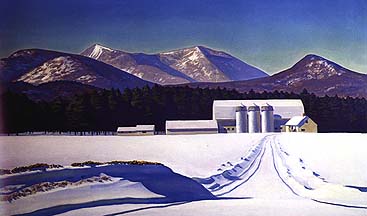
"The Road to Asgaard" by Rockwell Kent (Hermitage Museum)
|
Kent’s kayak from his time in Greenland is hanging from the roof.
No postcards (apparently a copyright problem). We bought note
cards and a t-shirt and started back to the car, stopped at a
huge Kent poster mural (maybe 6 X 10) and headed out. A fabulous
series of events.









